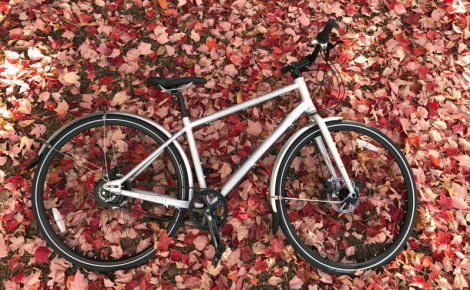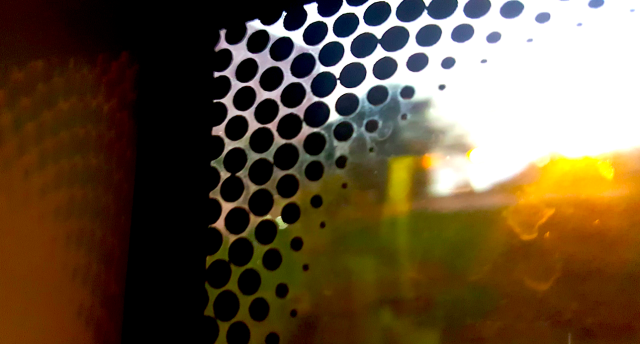For the past three months, I've been riding the Priority Bicycles Continuum, a commuter bike outfitted with a handful of low-maintenance components and a drivetrain system with an "infinite" number of gears. It's been an absolute joy to ride and has regularly shaved about 15 minutes off my hour-long trips around Brooklyn and Manhattan. Besides being low maintenance mechanical wonder this thing moves seriously fast.
Image: Gizmodo / Michael Nunez
The Continuum gets its name from the continuously variable transmission (CVT) hub located on the rear wheel that gives the bike a spectrum of gears rather than a fixed number. This style of hub gave me a much smoother ride than a derailleur system, since the drivetrain components weren't brashly jumping between fixed gears on different sprockets but instead smoothly moving over the surface of rotating balls.
The Continuum isn't the first vehicle to use a planetary gearing. It's also used in the transmissions of electric cars like the Toyota Prius or Tesla Model S. The concept of this gearing system dates all the way back to ancient Greece, but when used in commercially available bikes, they have usually cost thousands of dollars. Now, it's finally in a bike you can actually afford.
The balls, called planets, are on the inside the hub. When you crank the shifter on the handlebars, it tilts the axis of the balls inside the hub and changes their point of contact with the outer rings. This varies the speed ratio, or resistance you feel while you're pedalling. It also eliminates the need for clanking sprockets you'd see on the back wheel of a standard bike.
The rear wheel does not have a chain derailleur system. The gears are contained within the hub. (Image: Gizmodo / Michael Nunez)
For the rider, that means the shifters don't have any numbers and the bike doesn't have a jangling chain derailleur on its back wheel. The entire drivetrain is concealed in the hub and couldn't be easier to operate. (You can learn more about how the CVT hub works here.)
The first thing I noticed once I hopped on the Continuum is the little man on the shifter going up a hill. When you turn the shifter the indicator shows the man going up a steeper hill and means you're in an easier setting. Flatten the hill and you're riding with more resistance on the pedals, great for zooming along straightaways.
Image: Gizmodo / Michael Nunez
You'd think that you might feel a click when you crank the shifter or some other type of feedback to indicate it's working, but it's actually super quiet and really smooth. It's easy to get comfortable using the bike quickly because the gear system is so straightforward. The best part is I didn't have to worry about shifting while I pedal. The chain isn't gonna jump the gearing system if I try to shift while climbing a steep hill.
And there's an insanely steep hill in Brooklyn I have to climb up to get to my friend's house and across the major bridges. The hill starts at a red light, and I typically want to shift to an easier setting when I come to a complete stop (something you can't do with a chain derailleur).
Standard bikes run the risk of chain derailment at the hill. It's also one of the more dangerous areas in all of Brooklyn to ride so I approach it with extreme caution. It's not a place I ever want to worry about my bike's components.
Riding on the Continuum, the thought of component failure never crosses my mind. During my entire ride, I'm completely focused on my level of comfort and whether my legs are getting tired. It's amazing what this will do for the overall speed of your trip. I started taking the fastest possible route more often — regardless of how steep the hills might be — and focused my attention on the road.
Image: Gizmodo / Michael Nunez
The whole "low-maintenance" mantra of the gear system extends to almost every component on the bike. Like the belt drive system. It is by no means a brand new innovation, but they are still relatively uncommon in the United States (despite being extremely popular in Europe).
Instead of a greasy metal chain the system uses a rubber belt that is fixed to the real wheel cog and chain wheel — so it never moves. It literally just sits in the same place at all times. This means fewer moving parts and one less thing to worry about.
Gates, the maker of the belt drive, claims it lasts about 10 times longer than metal chains, and it's easy to imagine after a few months using it. The drivetrain has shown no signs of significant wear even after riding through rain and snow. It's rust-proof, never needs grease, and most importantly, provides a smoother ride because it's not rattling like a goddamn metal chain would.
Image: Gizmodo / Michael Nunez
The belt drive alone has changed my life, and now that I've used one, I'm never ever going back to using a bike with a metal chain. I can't emphasise how much smoother the ride is and the immense benefit of getting rid of the chain derailleur.
Priority Bicycles made its name by lowering the cost of the belt drive system in the US. When the company launched in 2014 with its first "maintenance-free" bike for just a few hundred bucks, it quickly became wildly successful Kickstarter project. The problem with the original bike was that it was too lightweight and didn't have enough gears for long-distance commuting.
That brings us to the biggest and most important question: is the Continuum worth its steep $US900 ($1173) price tag? From a purely economical standpoint, it is. You're not going to find a better combination of these parts for this cheap because they were hand-sourced from an obsessive mechanic (Priority Bikes founder David Weiner) who has spent his entire career in the bike industry.
That being said, $US900 ($1173) is a lot of money for casual riders. It's safe to say a large majority of people would be better off getting a bike half as fast at half the price. When I'm running errands, I typically don't use the Continuum. I stick to riding a recreational bike with fewer gears and cheaper parts. But for those times when I need do something like the ride from Brooklyn to Manhattan, I jump on the Continuum. I have yet to ride a bike as fast, and I'm certain I'd have to spend more than $US1000 ($1303) to find something that can perform nearly as well. The Continuum is in an awkward middle ground between recreational and professional touring bikes — but for a frequent commuter like me it hits the sweet spot.
README
- The CVT hub's infinite gears makes going uphill ridiculously comfortable. I expend less energy and move significantly faster.
- The belt drive will change your life. I'm never going back to a metal chain.
- Puncture resistant tires means I've never had to worry about potholes or broken glass on the road.
- The $US900 ($1173) price tag is steep for anyone and should really only be a consideration for serious commuters that want a fast, durable bike.
- The CVT hub adds a lot weight to the bike. At about 9kg, I would not recommend this bike for anyone with a walk-up apartment.






















Comments
Can you buy it in Australia without grey importing, or is this post useless to Aus readers?
lekker bikes sell a similar bike with the same hub gearing and belt drive for about $1500
And decades now in petrol and diesel powered cars as well, but any opportunity for a Tesla plug.
Yep..
every Automatic transmission has planetary gears, albeit used in a discrete shifting fashion..
Even the Model-T ford has/had planetary gears.
(Orig Article) Tesla isn't a good example as it too doesn't have (any) continuously variable ratios either.
Don't forget that the Nuvinci device isn't a planetary gearset anyhow (no gears).. It is a spherical friction drive (some inefficiencies compared to epicyclics) with more in common to toro's lawnmowers than any CVT used in cars.
Last edited 05/02/17 3:21 pmThe best part is that the author is wrong - the Model S does not use a CVT, it has a single, fixed ratio, like the vast majority of EVs.
Ahh, no thanks, that weighs more than my bike!
I think the 9kg was in reference to the whole bike, not just the gear system. I checked the manufacturer's website but couldn't find a weight for just the hub.
Edit: Scratch that, I found tech specs finally. The hub is 2.4kg on its own.
Last edited 06/02/17 9:22 amI doubt it. My aluminium frame 29er weighs more than 20kg and the bike in the photos doesn't look like a carbon frame. I can't see where the 9kg comes from but maybe it is the whole drivetrain - hub, front sprocket and drive belt?
You've got a very heavy bike at 20kg, most street bikes are around 10kg total. In any case, the manufacturer lists the N330 hub as 2.4kg, I doubt the rest of the drive train is going to weigh as much as a typical street bike.
I bought the strongest frame I could find, another few kg on top of my own 120kg is not a problem. In fact, the heavier the bike is, the more value I get from the exercise of riding it, as well as carrying it up/down stairs.
If you spent that much on a derailleur bike you'd eliminate most of the problems you listed
Maybe he doesn't want to get it pinched? I do find it a bit funny that he thinks $1200 is expensive for a bike.
I'll stick with my internal hub gear bike. Eliminates all the derailleur problems mentioned, and a fraction of the price mentioned.
Ignore this, please, expanded upon below.
Last edited 06/02/17 11:30 amUmm how about 11 for the current Shimano Alfine internal geared hub ( available in DI2 if you want it) .. combine it with a triple chainring up front and you have 33 gears
What does "D12" mean? For me, it's the front sprockets that cause all my problems. I can change up/down all day on the rear derailleur but about one time in four the front will throw itself right off the inside, always at precisely the wrong moment. It's really annoying so if I were to go hub gears, I'd want to go all the way and get rid of both front and rear derailleurs. In fact, I'd want to go belt drive if I could.
DI2 is shimano's electronic shifting. No cables, uses electronic wires and small motors to shift.
In your case, you could also consider a "1x" system. There is no shifting at the front, only the back.
Yeah, but then you have to decide whether you want to be able to go up hills and be really slow or be able ot keep up with other cyclists but not be able to climb hills. If I never needed the front sprockets, I could simply choose not to bother with them but I absolutely need the small one for steep hills and the large one for speed. All up, I would need probably three more gears, as the front sprockets translate to roughly 1.5 rear gears.
1x systems have a wide enough range that you can do those things
I've looked into it a little and never found a rear cassette with anywhere near the spread I think I'd need. That was at least 10 years ago, though, so maybe things have changed/improved. It may be worth revisiting, although I have to say I am pretty keen on the idea of hub gears and a belt-drive system. Bikes-on-line offers a 14 day test-ride, which I assumes means you can return it if you don't like it, so I may try out one of their bikes with hub gears and belt drive. They are selling the Polygon Path i8 for $999, which looks like a pretty decent commuter option.
Modern rear cassetes have 11 gears on the back, which is plenty for what you want. The polygon path i8 looks solid, though I would personally buy the path 9.
Not if they are the same high and low with more in-between options. You have to look at the spread of ratios and most 10-speed cassettes have the same high and low as my 8-speed, so that doesn't help.
if your having problems at the crank set (front cogs, mountain bike triples etc.) you probably have an indexed shifter there.
Cycles like the Surly Long Haul Trucker have an unindexed shifter for the crank
(as only the cassette needs indexed shifting) so is therefore near infinitely adjustable as the chain angle changes with shifts on the (rear) cassette. fixed.
If the Continuum is so great, why use a conventional bike for running errands?
Derailleur riders should realise that their system was invented for racing and not for city riding reliability and efficiency. If you are a commuter then a hub gearbox is a better choice. And fit mudguards so that you can ride when it rains without that wet stripe up your back.
What is the spread of gears like? I have a couple of steep hills, one of which is very long, on my commute, which means I need low gears to get up them in the morning and high gears to maintain my speed at the bottom of them on the way home. On my 27 speed bike I use all the gears from low-range 3rd, right through to to high-range 9th, every day. Do you think an 8-speed hub would work for me? Because I hate derailleurs and chains and all the rest of it.
I have had an Alfine 8 speed hub for 4 yrs/50,000km now, and can only remember wishing for another gear maybe... twice? three times? Not many!!!
Author most likely got the bike for free, wants to keep getting free stuff, so he is obliged to write a positive review.
It's illegal not to disclose information like that, they seem fine declaring interests on other articles.
Join the discussion!
Comment Voting
Up Votes
Down Votes
Only logged in users may vote for comments!
Please log in or register to gain access to this feature.
Get Permalink